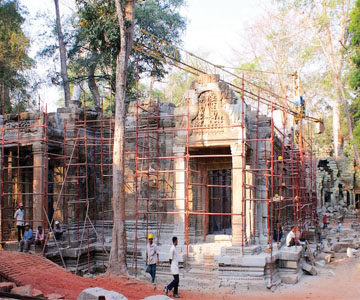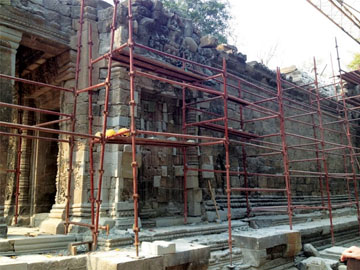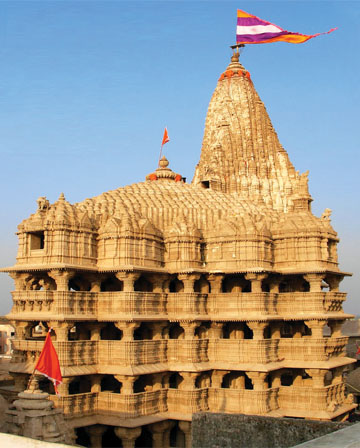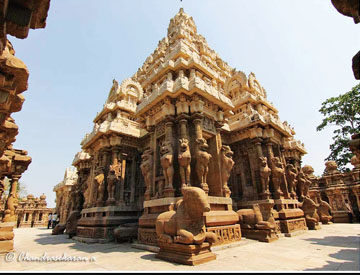Hriday-Searching the Heart of Conservation
Cultural heritage also includes crafts, textiles, jewellery, languages, literature, food and trade, which evolved through the history. All these are the sources of identity and pride, which deserve to be carefully conserved.
Introduction
The built heritage of India is the manifestation of its unique cultural diversity. It is an irreplaceable and non-renewable cultural resource. India’s historic cities and villages, gardens, water structures, forts and citadels, places of worship, tombs and memorials reflect its rich heritage. Cultural heritage also includes crafts, textiles, jewellery, languages, literature, food and trade, which evolved through the history. All these are the sources of identity and pride, which deserve to be carefully conserved.
However, due to rapid changes in economy and urban character, the heritage properties are getting converted or demolished. In many cases, negligence, lack of resources, and non-maintenance have caused gradual decay of the heritage structures. As recently witnessed in Nepal (Kathmandu and Bhaktapur), and earlier in Gujarat (2001), Kashmiir (2005) and Uttrakhand (2013), there had been serious damage to heritage structures due to earthquake, floods and other disasters.
The heritage of historic cities is also threatened by poverty and negligence on one hand, and economic growth and modernization on the other. Rise in land values and economic pressures are leading to the destruction of historical properties and the expulsion of vulnerable social groups by the extraneous commercial interests. In many places outdated rental regulations contribute to deterioration as lower rents do not allow any maintenance.
 |
The Ministry of Urban Development in January 2015 launched the Heritage City Development and Augmentation Yojana (HRIDAY), which starts with 12 pilgrim heritage cities, viz., Ajmer, Amrawati, Amritsar, Badami, Dwaraka, Gaya, Kanchipuram, Mathura, Puri, Vellankanni, Varanasi and Warrangal. With 100 per cent central government funding, it aims at improving the quality of life with focus on sanitation, security, tourism, heritage revitalization, livelihoods, and retaining the city’s cultural identity towards their integrated, inclusive and sustainable development. HRIDAY endeavours in bringing together urban planning, economic growth and heritage conservation with focus on livelihoods, skill development, cleanliness, security, accessibility and service delivery. Restoring the heritage character of the city goes hand in hand with improvement of housing, services and sanitation.
Understanding the Built Heritage
However, the question remains how to go about it. Understanding the people, place and time is integral to the concept of the heritage. It helps to appreciate the heritage as a resource. All natural and built heritage resources need to be protected keeping the people at centre of plans and programs. This demands a sensitive and futuristic vision to manage the past. The conservation is not freezing a place in time or denying development. Rather it stresses that the development has to occur in relation to the existing built heritage and in relationship with its natural context. Effective protection and management of heritage requires its integration with overall planning and development process. The purpose of the conservation of heritage is to relate it with the local people. Heritage conservation has to be inclusive, which imbibes ethics, employment, education, ecology, empowerment, enablement and equity. Rather than being monument centric, the approach to conservation of heritage has to consider the settlements and neighbourhoods and adopt a wider process of participation and partnerships. Accordingly, the efforts for the conservation of heritage must address the issues of local community development.
|

|
| Inner cities in India have a vast potential for socio-cultural and economic development. They are located at the crossroad between past and future. They should not be treated as a museum but as a vibrant, living neighbourhood. |
Inner cities in India have a vast potential for socio-cultural and economic development. They are located at the cross-road between past and future. They should not be treated as a museum but as a vibrant, living neighbourhood. The conservation process requires a sensitive and careful approach and use of the traditional materials and methods. The craftsmen who have the indigenous skills should be encouraged to use and spread their knowledge.
Process
Conservation and revitalisation process involves a detailed and sustained situation study, analysis and diagnosis, vision and action, monitoring and learning experience. This needs a systematic identification, grading and documentation of cultural heritage, its typologies and developing a comprehensive framework of heritage management, planning and engineering for conservation and restoration. A step-by-step approach should be adopted towards urban conservation, as given IN Table 1.
TABLE 1: Urban Conservation Process and Sequence
| STAGES |
MAIN ELEMENTS |
|
Diagnosis Situation anaalysis and inventry
VISION Development of a collective vision and strategy
ACTION Development and implementation of action plans, projects and programmes |
- Comprehensive assessment of the historic district in relation to its position and role in the city at large, including demo-graphics ,socio-economic profile, housing, infrastructure and services, informal sector assessment, environmental profile, etc.
- SWOT (Strengths-Weaknesses-Opportunities &Threats)analysis
- Inventory of all resources in and around the historic district like cultural, environmental (potential greening of the district),human and socio-economic(potential economic development linked to traditional know-how, etc.),available and potential resources for the district’s economic development
- Listing of prominent heritage structures.
- Identification of key stakeholders and preliminary consultations on situation analysis
- Stakeholder consultations on concerns, aspirations and fears; developing a collective vision for revitalisation of the historic district
- Identification of project objectives and strategic areas for intervention-concentrating on “what”, “how” and “for whom”
- Prioritization of interventions, focusing on those which respond to cross-cutting requirements
- Development of action plan(s) for priority strategies, linked with broader development programmes (ongoing/planned)
- Integration of short-and long-term plans
- Feasibility assessment, establishment of time-frame and resources required.
- Impact studies of priority projects in close cooperation with all stakeholders
- Identification and mitigation of risks
- Resource mobilisation (physical, financial, human, technical, etc. for action plan implementation
- Development and negotiation of public-private-community partnerships
- Establishment of flexible and transparent procedures
|
|
Project and Program
Monitoring and Evaluation (M & E)
Capitalization learning from the Experience |
- Integration of short and long term plan
- Feasibility assessment, establishment of time fram
- Development of clear indicators for monitoring and evaluation, including quantitative and qualitative indicators
- Establishment of M &E procedures
- Involvement of all major stakeholders in monitoring and evaluation
- M & E adopted a sale and training exercise
- Identification of lessons that can be applied to other districts in the same city or other cities.
- Integration of innovative practices into established procedures
- Promotion of lessons learnt for and by inhabitants to valorise their participation to the process and create a feeling of belonging. This will reward their efforts and inspire inhabitants of other historical areas.
|
For the revitalisation of historic cities, villages and zones, some broad guidelines include the following:
- A comprehensive approach integrating conservation with improvement of the community in term of livelihoods, incomes, education, health, recreation, culture and security.
- Refurbishment standards for the restoration of areas and buildings of historic and cultural significance.
- Traffic improvements, pedestrian pathways, signage and street furniture to increase public use and improve mobility and public convenience.
- Reintegration of historic centres into mainstream activity, which involves a clear definition of functional requirements.
- Improved environmental standards.
- Regulation and control over hoardings, signage, advertisements.
- Community participation and cultural revival, local festivals and performing arts.
To make conservation and urban regeneration sustainable and self-supporting, participation of the community/NGOs involvement is necessary. It is essential to provide incentives to heritage building owners. The project approach should be bankable so as to mobilise private sector investments. This would help to leverage the process of urban conservation by private/community investments.
Often the Development Plans prescribe the Floor Area Ratio (FAR) for inner cities and traditional zones, which is generally much less than the existing. The FAR corresponds to property value; hence its reduction can be a major disincentive for conservation. As a result unauthorised reconstruction and conversions of land use take place. It is necessary not only to allow minimum existing FAR and ground coverage, but also to give an incentive FAR and retain property value by way of planning tools such as Transferable Development Rights, adaptive reuse and mixed land use. The Transferable Development Rights (TDR) can be applied to privately owned premises that are listed monuments located in heritage cities and zones.
|

|
Home improvement loans can be given for maintenance of old buildings as has been tried in Mumbai for repair of chawls.
|
For the buildings affected by heritage restrictions (including buildings falling in 100m and 300m radii prohibited and restricted zone around notified archaeological monuments) entitled FAR can be granted either in situ by enhanced ground coverage and adaptive reuse, or in a receiving plot within the zone by way of DCR. As far as possible, TDR should be granted in the same locality /area having similar property value. The owner can be given a choice to avail land, Transferable Development Right Certificate/Floor Area Ratio, or cash compensation or a mix of the three options. Hyderabad, Ahmadabad and Bangalore have used the tool of TDR for its road widening projects/public transport corridors. However, it is yet to be used for heritage conservation.
To encourage owners of listed/ notified heritage properties and monuments to invest in the conservation, they can be offered alternative plots of land for development to compensate for the loss of development potential in a heritage property. Waivers of building bye-laws for protection of heritage may include set-backs, marginal open spaces, height, etc. This demands a clear framework and comprehensive plans for heritage zones emerging from ground level experience. The owners and occupants of heritage buildings/zones may be allowed adaptive reuse and ‘remunerative’ activities, which are not hazardous to conservation and environment. Home improvement loans can be given for maintenance of old buildings as has been tried in Mumbai for repair of chawls. This helps in proper maintenance of traditional housing stock without need to shift the population and save such properties from becoming real estate commodity. The local body may take up from its own budget infrastructure up gradation schemes for inner city/heritage zones and dilapidated old areas
Heritage Management
The preparation of a Heritage Management Plan is based on a detailed documentation, surveys and mapping of the heritage resources. It follows a sequential and systematic study as given below:
- Surveys, ground penetrating radar survey, high definition 3 D geo-technical assessment, Total Station Survey, documentation, listing and grading.
- Layered maps and visuals of historic evolution
- Heritage maps and chronology of historic cities, villages and settlements:
- Morphology of natural heritage.
- Neighbourhoods (mohalla and katra), clusters, bungalows, administrative buildings, urban elements, roads and streets, infrastructure services such as water tank, reservoir, wells, service lines, etc. .
- Listing and grading of public and private buildings, havelis, forts, palaces, mosques, sarai, tombs, walls and gates, hunting lodges, gardens, water structures, archaeological mounds, natural features, etc.
- Delineation of heritage buildings and zones on detailed maps.
Analysis and inventory of issues and priorities: Diagnostic surveys should be undertaken at building, precinct/zone and city levels to identify the various areas of intervention, such as traffic, pedestrianisation, roads and paths, tourist/pilgrim facilities, barrier free access, infrastructure improvements, public toilets, signage, hoarding control, pollution control, development control, TDR, adaptive use, etc. At building level, it may need conservation, elevation control, painting and plaster, colour and material specifications, removing vegetative growth, leakages, seepage, structural strengthening of the roof/dome, foundation, walls, rehabilitation, refurbishing, restoration, etc.
- Guideline for overall conservation and management, along with working drawings, details, specifications, estimates, architectural and building controls/regulations.
- Environment Management Plan.
- Infrastructure Management Plan.
- Mobility Plan (including access of the disabled, wheelchair users)
- Heritage legislation/rules, regulations and bye-laws
- Financial plan and action programme
- Documentation and knowledge management
- Monitoring, evaluation and feedback.
In the absence of dedicated specifications for heritage construction and materials, general specifications are often adopted for heritage conservation. There is a need to work out specific guidelines and specifications of materials for conservation, repair and maintenance of heritage structures. These should be differentiated according to the historicity, age, and structural condition and grading of the heritage resources. Technical assistance to heritage conservation projects can be provided by the local bodies/NGOs and professional institutes. Accordingly, procedures will have to be evolved for effective participation of the NGOs, the cooperative, community and the private sector.
During the last decade three conservation zone heritage projects had been undertaken in Delhi, viz. (i) Humayun Tomb-Nizamuddin- Sunder Nursery, (ii) Mehrauli Archaeological Park, and (iii) Jama Masjid and precints. Humayun Tomb-Nizamuddin- Sunder Nursery was taken up by Aga Khan Foundation in partnership with the Ministry of Culture, ASI, MCD, and CPWD and major work has been completed. Mehrauli Archaeological Park has been taken up by the DDA and ASI in partnership with the INTACH. Jama Masjid project of the MCD/GNCTD is yet to take off. The experience indicates that conservation management involves a patient, continuous and painstaking efforts. Such projects can hardly succeed if taken up on lines of architectural design consultancy. These need dedicated, long term partnership with the NGOs, experts, specialist craftsmen and local community. That is how some conservation projects like Humayun Tomb-Nizamuddin- Sunder Nursery have been implemented.
The Pillars of Heritage Management
Three pillars which support the superstructure of heritage management are:
- Institutional and organizational capacity,
- Finances, and
- Legal framework
No heritage management plan can be successful without these three pillars. Many local bodies and heritage property owning agencies/trusts do not have in-house specialists in urban heritage planning and architecture and engineering. They have no option but to outsource the work or partner with specialized, credible consultants or NGOs. This has to be done in a manner which is transparent, timely, and economical and gives value for money. This needs a cautious approach, where emulating consultancy process of architectural jobs or contractual procedures may not work. Heritage Cells and Heritage Conservation Committees have been constituted in various cities, which have been quite effective in giving dedicated attention to urban heritage.
The conservation process is a set of various stages, which involves policy framework, benchmarks and standards. Evaluation of planning options by SWOT analysis, cost benefit analysis, feasibility and viability assessment, resource planning, identifying key issues via-a-vies resource assessment, empowerment of the community and participatory planning’ Mobilising the finances for heritage conservation is a critical issue. For most of the local bodies, it may not be possible to spare adequate funds for such work. By a creative approach, such as starting heritage management with low hanging fruits the need of finances can be minimised. For example, in most of the inner cities or heritage zones by regulating, removing and or redesigning the hoardings, banners and billboards on the building and roads can make a huge difference. Façade repair and painting can be another starting point. Funds can be mopped up from various schemes such as Heritage City Development and Augmentation Yojana (HRIDAY), National Culture Fund and Plan Funds. State government budgets are also available for repair, reconstruction infrastructure, development, drainage, sanitation, toilets, roads and streets, etc. Partnerships with the private sector, NGOs and Corporate Social Responsibility (CSR) can be other sources of financing the heritage projects through tax incentives.
 |
All public schemes need a legal framework, standards, operating procedures and controls for their implementation, financing and enforcement. These can be in the form of Town Planning laws, Development Control Regulations, Heritage Acts, Rules and Regulations, Hoarding and Anti-defacing Law, Building Bye-laws, Specifications and norms. Codes and Para-legal tools, such as architectural controls, PPP guidelines, social audit, community empowerment norms and heritage toolkit are the pre-requisites for effective heritage management.
References:
- Aga Khan Trust for Culture, The Revitalisation of the Gardens of Emperor Humayun’s Tomb, AKTC; Geneva, 2003.
- Cantacuzino, Sherban, Blueprint for Conservation in the Third World, Mimar 24, 1987
- I INTACH, Charter for Conservation of Unprotected Heritage in India, New Delhi, 2004
- Jain A.K., Conservation of Cultural Heritage, Discovery Publishing House, New Delhi. 2015.
- Jain, A.K., Lutyens Delhi, Bookwell, New Delhi, 2011
- Jain A.K., Smart Cities – Vision and Action, Discovery Publishing House, New Delhi, 2015
- Jain, A.K., Dillinama-the Cities of Delhi, Synergy Books, New Delhi, 2014
- Jain Shikha, Havelis- A Living Tradition of Rajasthan, Shubhi Publications, 2004
- Menon, A.G. K. Heritage Conservation and Urban Development: Beyond the Monument, Heritage
- Conservation and Urban Development, Hyderabad, India, INTACH, 2005.
- Riberio E.F.N & Jain A.K. (Eds.). The Future of New Delhi, Delhi Development Authority, New Delhi, 1984.
- UNESCO, Historic Districts for All, New Delhi, 2010
About Author:
Ex-Commissioner (Planning) DDA, worked on Master Plan for Delhi-2021, Heritage Policies, Tool-kit and Projects, Consultant UN Habitat. Extract of book ‘Conservation of Cultural Heritage, Discovery Publishing House, New Delhi, 2015 ak.jain6@gmail.com